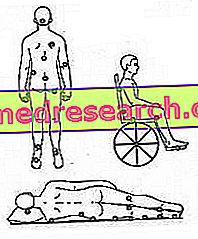Definition
Decubitus sores, also known as compression sores or pressure ulcers, are difficult to heal wounds, skin lesions that usually lead to tissue necrosis: the sores do not only affect the superficial layers of the skin (epidermis, dermis) but go deeper, until it reaches the subcutaneous layers, the musculature and the bones.

Causes
The cause that leads to the formation of pressure sores is not degenerative, nor infectious or unknown: the lesions are caused by a static position of the subject, forced to prolonged immobility for various reasons, such as plastering, breaking of limb bones, severe obesity, pregnancy at risk (which forces the woman to immobility in bed); sometimes, even the use of drugs can cause the subject to stay in bed. In such circumstances, the subject is forced to assume a static position, which causes an incorrect local blood flow, because the blood vessels undergo a compression; this results in an increase in pressure which, exceeding 40 mm of mercury, could cause obstruction of the vessels, coagulation and tissue death (necrosis).
Prevention
It should be remembered that pressure sores can be prevented with the help of family members or competent health personnel, attentive to the patient's needs: every two to three hours the subject should be helped to change the position, to stimulate blood circulation ; the diet should be very careful and regular, as well as the hygiene of the body: not excessive but adequate. Furthermore, specific and targeted aids for the prevention of sores, such as pillows, mattresses, disinfectants, bandages, dressings, etc, should be used; hospital staff or family members must also consider any pre-existing pathologies (eg liver, metabolic, neurological disorders).
The prevention of pressure sores is essential for the good health of the subject; in fact, the injuries that can result to a forced immobility can cause very serious effects, also affecting muscle and bone tissue. The damage caused, the greater the longer the time of immobility, can be such as to induce the death of the person: precisely for this reason the help of the competent personnel is indispensable, which can and must prevent more serious consequences.
Compression sores cannot be considered "normal" wounds, since they cannot heal spontaneously, rather they tend to become chronic; based on the severity of the sore you can use natural remedies (for low-grade ulcers) or drugs (if the sores degenerate in the critical stages reaching muscle and bone).
Symptoms
To learn more: Symptoms Pressure sores
The level of least danger is characterized by erythema, thickening, hardening of the skin and loss of the natural color of the skin; then the lesion can progress showing lesions, blisters or abrasions in the epidermis and dermis. If the damage becomes more and more consistent, it could affect large areas causing degeneration and death of the subcutaneous tissue (necrosis), slightly involving the muscular tissue. In the last stage, which is the most risky for the subject's survival, the lesion extends from the muscles to the bones, from the tendons to the cartilages.
Care
As far as possible treatments and treatments are concerned, if the decubitus sore is low and reversible, the use of targeted herbal products could be a good solution, obviously with the doctor's advice. If, on the other hand, the lesion is more serious, the expert must direct the patient to the use of adequate drugs, such as becaplermin and cadexomer iodine, which can prevent the plague from becoming chronic and activate the repair processes of damaged tissue.
The topical use of disinfectants (such as modern silver nanocrystals ) is a good aid to reduce the bacteria that have settled in the pressure sores: the antibacterial substances help not only to create a balance of bacterial charge, but also to decrease the formation of necrotic bodies and fibrin, reducing the dressing frequency of the sores.
Summary
Causes | Event | Hazard levels |
| Limb fractures Severe obesity Pregnancy at risk (immobility in bed) Use of drugs ASSOCIATED WITH ... Poor hygiene Static position Malnutrition Mattresses, bandages, inadequate dressings | Decrease / loss of skin sensitivity Localized bacterial infections Depression Pre-existing disorders of the subject (liver problems, metabolic disorders etc.) |
|
Complications | Pressure sores: prevention | Cures and treatments |
| Dehydration Anemia / hemorrhage flaking Redness Bone decalcification Electrolyte imbalance | Change the patient's position often Use medication (if necessary) Proper nutrition Hygiene Practicing physiotherapy Hydration Muscular reinforcement | Use of antiseptic products (disinfectants) Use of herbal products (if the disorder is mild) Use of drugs for advanced stages (becaplermin and cadexomer iodine) |



